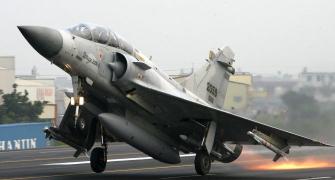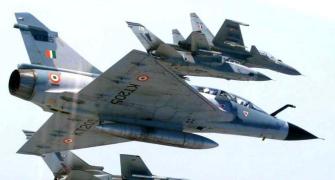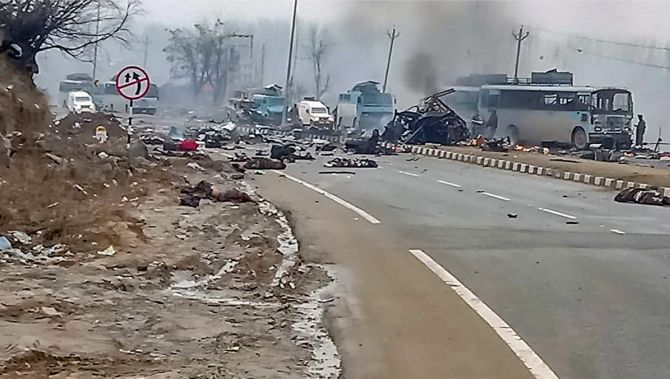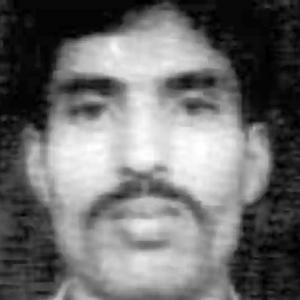'If the other side knows you are coming, then you are the guy who is going to be dead.'

Early on Tuesday morning, February 26, 2019, Indian Air Force pilots got into the cockpits of 12 Mirage 2000 fighter jets from Madhya Pradesh and took off in batches towards Pakistan.
The aircraft -- that had played a stellar role in strikes on Tiger Hill during the Kargil War -- were headed towards terrorist training camps deep inside Pakistan.
The aircraft were armed with laser guided bombs, and fitted with Israeli litening targeting pods.
The pilots conducted final checks on the targets and got a clearance from the command centre to cross the Line of Control.
They flew low undetected by Pakistani radar.
Four Sukhoi-30s provided air cover.
An early warning jet flew from Punjab.
A mid-air refueling tanker, the IL-78, took off from Uttar Pradesh.
An IAF Heron surveillance unamanned aerial vehicle accompanied the team to monitor Pakistani aircraft and radar.
An Embraer aircraft fitted with the Airborne Early Warning and Control System was used for air coordination.
The pilots of the Mirage 2000 jets used laser pods to home in on the targets. The laser bomb basically rides the laser beam on to the target.
Finally, the jets dropped their bombs on Jaish-e-Mohammad camps and returned to India before Pakistani air defences got wind of it.
The entire mission -- which involved Indian aircraft entering 10 miles of Pakistan airspace -- took about 17 minutes.
"In the IAF, pilots are the ones who will go across into enemy territory. They go deep inside, fight their way in and fight their way out. They need very high degree of training, confidence, self belief, risk taking ability and courage. But a whole amount of infrastructure backs them up, you can't do without it," a retired Mirage 2000 pilot tells Rediff.com's Archana Masih.
How long would the jets have stayed in Pakistani airspace for an operation like this?
It would be difficult to say, but it must have been a few minutes. You have to go in fast, hit hard and come out. You don't linger around.
These operations are very well planned; the routing is known and the plan is imprinted in the pilots's minds.
Once you have hit the target, the other side would scramble their interceptors and target you so pilots want to deliver the weapon and quickly come out.
How quickly can enemy jets be scrambled for retaliation when you are in enemy airspace?
That would depend on the level of alertness, and according to the environment after the CRPF attack, they were in a pretty high level of alert.
Their radar must be looking, but in modern warfare you prepare/shape the battlefield by degrading and destroying their defences.
You jam their radars, have decoys etc to confuse the enemy and delay his response.
The idea is that by the time he responds, you have already dropped the weapon and are back.
A lot of preparation goes into an operation like this.
It is not just one aircraft going and dropping a weapon. There is a huge amount of associated tasks happening to make that happen.
The number of aircraft depends on the targets.
What risks are there for pilots who fly these jets into enemy territory?
Pilots are aware of the risks. It is their job. They are prepared to fight their way in and fight their way out.
There is a trained air force on the other side who are passionate about defending their airspace.
So you have to be fully prepared -- go in, beat them and get back.
How are pilots selected for such missions?
The IAF trains its pilots in peacetime for such missions. They are available at the squadron and ready at short notice.
The attack (the February 14, 2019 suicide bombing at Pulwama which killed 44 CRPF soldiers) happened 12 days back, so days must have been spent planning this. But pilots are trained to scramble in a few minutes.
What must have been in the crew room before the strike?
A very proactive environment. Pilots are fully focused on the job that is needed to be done.
They go over the procedures, contingencies, back-up plan, study the target, know exactly what they are supposed to do where and keep revising it.
Pilots are totally focused on the mission and cannot let the mind go anywhere else.
On return from the mission, there is a debrief. They go over what has exactly happened, take lessons from it and get ready for the next.
Are the most experienced pilots sent for such strikes?
The squadron will send experienced pilots, but younger pilots are also sent -- it depends on the composition at that time.
What is the worse thing that could have happened on a strike like this?
There are so many things that can happen when you are flying and one cannot say that this is the worst thing.
Pilots don't think of the worst, they think of the contingency and how to react to that.
There are so many things that can happen, you just have to be ready for them, that's it.
Missions like this have to go with complete surprise. They are not discussed.
If the other side knows you are coming, then you are the guy who is going to be dead.
You go quietly, probably a very few people knew about it. That's how you keep the surprise.
Fighter jets don't really have to fly to Balakot to strike the camps. Could they have launched targeted strikes from a few kilometres on the LoC on the Pakistani side?
There are long range weapons and aircraft that don't have to go over or near the target. It keeps you away from the surface to air defences of the enemy which are generally close to the target.
The range could be from a dozen to a few hundred kilometres, it depends on what weapon are being carried.
There were 12 aircraft that went on this mission, not all must have dropped weapons, some must have been there to provide cover. What are the different roles that jets play in such operations?
It is a coordinated mission, multiple things are happening at the same time.
Aircraft are used for jamming radar, creating corridors etc -- but the end result is dropping the weapon on the target.
Everything is done to prepare and create the environment for that.
How is the decision made on what aircraft will be used for a strike?
It depends on the capability of the aircraft, the best and most potent aircraft would be used for a strike like this. It would have the technological capability in terms of weapons, the pods to carry bombs and the self defence equipment.
It has to be a mix of all such attributes. The Indian Air Force has a lot of aircraft that do that.
What makes the Mirage 2000 suitable for such a mission?
The Mirage 2000 is a very capable multi-role aircraft and one of its roles is to do an operation like what was done this morning.
Such strikes need precision strike capability to deliver weapons accurately and the Mirage 2000, Su-30 -- most IAF aircraft have this capability today.
The Mirage 2000 remains a most potent platform as it proved 20 years ago in Kargil and it has done so again today.
What are the bombs carried on the Mirage 2000?
Two kinds of bombs -- conventional bombs that can be dropped and the laser guided bombs launched from a pod in the aircraft.
The laser bomb basically rides the laser beam on to the target.
What kind of response could a strike like this elicit from Pakistan?
It depends on the other side and you cannot control that.
We should be ready for any response. We can show our deterrence.
When a mission like this is undertaken, retaliation is expected.
Even before conducting an operation, you are ready for retaliation and your defences are already up.
You do not wait to strike and decide what the retaliation is going to be.
After suffering crashes and loss of pilots this month, this must come as a morale booster to IAF pilots.
It takes many years to train a fighter pilot with crores of investment. Aircraft can be replaced, but you cannot replace the experience of a pilot.
I am sure people are feeling great, but the Indian Air Force is a professional air force, you don't get jingoistic about it.
It was a job that had to be done and it was done well.
It was a long time coming. They went across, did a good job and sent a message across that things are different now.
It has to be seen what happens next and you have to be ready for that. That is what is more important now, what is in the past has already happened.
Pilots who were on the mission must feel a real sense of achievement.
This is what IAF pilots are training for. While you don't want to have a war, but when it happens you want to go and do your best
This is what you train for and wait for.
In the IAF, pilots are the ones who will go across into enemy territory.
They go deep inside, fight their way in and fight their way out.
They need very high degree of training, confidence, self belief, risk taking ability and courage.
But a whole amount of infrastructure backs them up, you can't do without it.
While the guy in the cockpit presses the button and takes the maximum risk, there is a whole amount of infrastructure behind that is enabling you to do that -- AWACS, fuelling, technicians loading the bombs etc, everything has to work in synergy for the bomb to hit the target.
The success of the operation shows the professionalism of the IAF and the teamwork that goes into keeping our nation's airspace safe and delivering the lethal punch as and when mandated by our country's political leadership.










